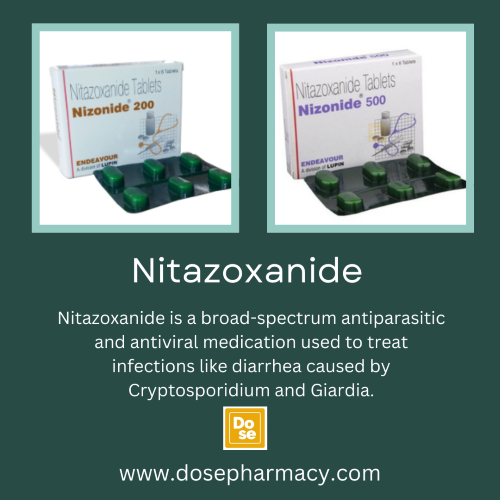Nitazoxanide 500 mg is an antiparasitic and antiviral medication widely used to treat various infections, including giardiasis, cryptosporidiosis, and viral gastroenteritis. It is known for its broad-spectrum activity against parasites, bacteria, and viruses. While nitazoxanide is highly effective, many patients wonder: how long does it take for nitazoxanide to work? The answer depends on factors such as the condition being treated, the patient's immune system, and adherence to the prescribed dosage. In this article, we will explore the timeframe for nitazoxanide's effectiveness and how to maximize its benefits.
How Nitazoxanide Works
Nitazoxanide 200 mg works by inhibiting the growth of certain protozoa, bacteria, and viruses. It interferes with the metabolic processes of these microorganisms, preventing them from reproducing and spreading. This makes nitazoxanide effective in treating infections caused by:
-
Protozoa (e.g., Giardia lamblia, Cryptosporidium parvum)
-
Bacteria (e.g., Clostridium difficile)
-
Viruses (e.g., rotavirus, norovirus)
Once ingested, nitazoxanide is rapidly converted into its active metabolite, tizoxanide, which reaches peak levels in the bloodstream within 1 to 4 hours. This rapid absorption allows the medication to begin its work relatively quickly.
How Long Does Nitazoxanide Take to Work?
The time it takes for nitazoxanide to show noticeable effects varies depending on the infection being treated. Below is a breakdown of the estimated response times for different conditions:
1. Giardiasis (Giardia Infection)
-
Symptoms Improvement: 24–48 hours after starting treatment
-
Complete Recovery: 3–7 days
-
Dosage: Usually taken twice daily for 3 days
-
Notes: Diarrhea and stomach cramps often begin to improve within the first 48 hours, but completing the full course is essential to eradicate the infection fully.
2. Cryptosporidiosis
-
Symptoms Improvement: 2–3 days
-
Complete Recovery: 7–10 days
-
Dosage: Twice daily for 3 days (may be extended in immunocompromised patients)
-
Notes: In people with a healthy immune system, nitazoxanide effectively clears Cryptosporidium infections in about a week. However, in immunocompromised individuals (such as HIV/AIDS patients), recovery may take longer.
3. Viral Gastroenteritis (e.g., Rotavirus, Norovirus)
-
Symptoms Improvement: 24–48 hours
-
Complete Recovery: 3–5 days
-
Dosage: Twice daily for 3 days
-
Notes: Studies suggest nitazoxanide can reduce the duration of diarrhea and vomiting caused by viral infections. Symptoms typically improve within 1–2 days of starting treatment.
4. Clostridium difficile Infection (C. diff)
-
Symptoms Improvement: 2–4 days
-
Complete Recovery: 10–14 days
-
Dosage: Typically taken for 7–10 days
-
Notes: Nitazoxanide is sometimes used for treating C. diff infections, especially in cases resistant to metronidazole or vancomycin. Symptom relief starts within a few days, but full recovery can take longer.
5. Hepatitis B and C (Experimental Use)
-
Symptoms Improvement: Varies based on patient response
-
Complete Recovery: No fixed duration (not FDA-approved for this use)
-
Dosage: May be taken for several weeks in clinical studies
-
Notes: Nitazoxanide has shown promise in clinical trials for treating chronic Hepatitis B and C. However, more research is needed to determine its long-term efficacy.
Factors That Affect How Quickly Nitazoxanide Works
Several factors influence how fast nitazoxanide works in treating infections:
-
Severity of the Infection – More severe infections may take longer to respond to treatment.
-
Patient's Immune System – A healthy immune system can speed up recovery, whereas immunocompromised individuals may take longer to respond.
-
Adherence to Treatment – Taking nitazoxanide exactly as prescribed is essential for optimal effectiveness.
-
Hydration and Nutrition – Proper hydration and a balanced diet can support recovery from infections.
-
Other Medications – Some drugs may interact with nitazoxanide, potentially affecting its absorption or metabolism.
How to Maximize the Effectiveness of Nitazoxanide
To ensure the best results while taking nitazoxanide, follow these instructions:
✅ Take With Food: Nitazoxanide is better absorbed when taken with a meal.
✅ Complete the Full Course: Stopping the medication early may lead to recurrence of the infection.
✅ Stay Hydrated: Drink plenty of fluids to prevent dehydration, especially if treating diarrhea.
✅ Follow Your Doctor's Advice: Always take the prescribed dosage and inform your doctor of any unusual symptoms.
✅ Avoid Alcohol: Alcohol can increase the risk of side effects like nausea and dizziness.
Possible Side Effects and When to Seek Help
Most people tolerate nitazoxanide well, but some may experience mild side effects such as:
-
Nausea
-
Stomach pain
-
Headache
-
Dizziness
Rarely, more severe reactions can occur, such as allergic reactions, yellowing of the skin (jaundice), or severe diarrhea. If you experience any serious side effects, seek medical attention immediately.
Comparison: Nitazoxanide vs. Other Treatments
Nitazoxanide is often compared to metronidazole for protozoal infections like giardiasis. While both are effective, nitazoxanide has fewer side effects and does not cause the metallic taste or alcohol sensitivity associated with metronidazole. Additionally, nitazoxanide has antiviral properties, making it unique among antiparasitic drugs.
Nitazoxanide is a powerful and versatile medication that typically starts working within 24–48 hours, with full recovery varying depending on the infection being treated. For conditions like giardiasis and viral gastroenteritis, improvement is usually noticeable within a couple of days. However, for more severe infections like C. diff or cryptosporidiosis in immunocompromised individuals, recovery may take longer.
To ensure maximum effectiveness, take nitazoxanide as prescribed, follow a proper diet, and stay hydrated. If symptoms persist beyond the expected recovery time or worsen, consult a healthcare professional. By understanding how long nitazoxanide takes to work and following best practices, you can optimize its benefits and achieve a faster recovery.




